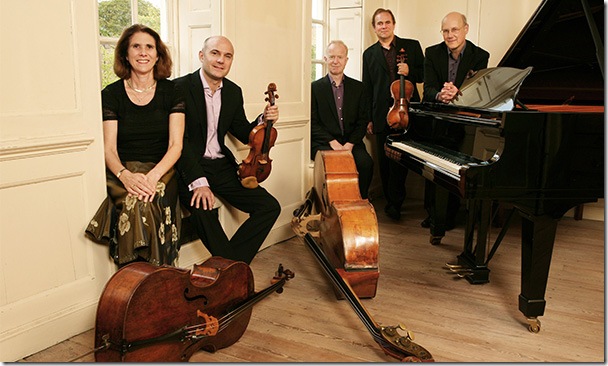Britain’s Schubert Ensemble came to the Flagler Museum for a night of music-making Tuesday; two familiar works and a couple of rarities made up their program.
As winners of the coveted Royal Philharmonic prize, Best Chamber Group Award in 1998, and shortlisted in 2010, this led to high expectations. There’s no greater honor in British music. The Royal Philharmonic Society, founded in 1813 to promote good performances and new music, in 1822 famously commissioned Beethoven’s Ninth Symphony.
Jane Salmon, the cellist, in her opening remarks, told of their concert in Philadelphia the night before in Alfred DuPont’s home, saying they were surrounded by indoor green houses with exotic plants, in contrast to Florida, where they were delighted to see so many similar flowers growing naturally outdoors. In their 30-year existence, this was their first visit to Florida (kudos to the Flagler’s John Blades for bringing them here).
A rare Gustav Mahler work, a one-movement Piano Quartet, written when he was 16 at the Vienna Conservatory, was their warmup piece. Reminiscent of the romantic music of Schubert or Brahms it’s a brilliant blend of the four instruments, piano, violin, viola and cello, showing complete understanding of this art form by one so young. A strident cadenza on the violin, played strongly by Simon Blendis, ends the quartet, sounding like a 16-year-old student’s cry for help ; his parents quarreled incessantly.
Next, came Mozart’s Piano Quartet in G minor (K. 478). Combining features of piano concertos and string quartets, Mozart broke the conventional mold of sonata for piano with strings by introducing a more difficult line for the pianist, giving solo strings much more work to do. The Allegro has the piano trilling, with runs and scales ad infinitum as the strings sound anxious , impassioned. The Andante has interlaced tunes flowing back and forth from piano to strings (so many tunes I lost count).
The Rondo is the most familiar of the movements with the piano leading off each tune as the strings repeat or vary the tunes at will. Pianist Paul Howard’s skills match that of Menahem Pressler, aside from poor fingering that drew my attention once or twice, a consequence of same-day travel and short rehearsal time no doubt.
Winding up this first-of-a-kind Piano Quartet is a grand finale. It must have made one heck of an impact on 1786 Vienna, and a breakthrough for audiences as so many composers later followed along in Mozart’s “new style.”
Robert Schumann’s Piano Quartet (in E-flat, Op. 47) ended the schedule. The Sostenuto assai, is a lovely movement, full of sensitive understated English playing, each instrumentalist proving a master. The Andante has the viola, ably played by Douglas Paterson, leading with graceful arpeggios accompanying from the violin: a nice collaboration here, while the cello plucks away contentedly. The Finale has muddy drawn-out passages with the piano trying to break this languid melancholia. It succeeds and a vigorous Vivace, full of good spirits, brings closure.
For an encore, the Schubert Ensemble played the other rarely heard piece, by the British light-music composer Max Jaffa, so familiar to BBC listeners in their “Palm Court” music series of yester year.
The next concert in the Flagler Museum series features the Vienna Piano Trio on Tuesday, Feb. 19. The Austrian threesome has scheduled music by Haydn (Piano Trio in C, Hob. XV: 27), Beethoven (Piano Trio in E-flat, Op. 44) and the Trio No. 2 (in E minor, Op. 92) of Camille Saint-Saens. The concert is set for 7:30 p.m.; tickets: $60, includes champagne reception afterward. Call (561) 655-2833 or visit www.flaglermuseum.us.
